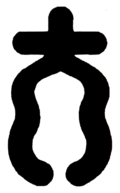Aizukotetsu-kai
 The daimon of Aizukotetsu-kai | |
| Founded | 1868 |
|---|---|
| Founder | Senkichi Kousaka |
| Founding location | Kyoto, Japan |
| Membership | 30[1] |
| Leader(s) | Toshinori Kaneko |
The Seventh Aizukotetsu-kai (七代目会津小鉄会, Shichidaime Aizukotetsu-kai) (sometimes written Aizu-Kotetsukai or Aizu Kotetsu-kai), based in Kyoto, is Japan's yakuza organization. Its name comes from the Aizu region, "Kotetsu", a type of Japanese sword, and the suffix "-kai", or society.
In 1992 the Aizukotetsu-kai became one of the first yakuza syndicates named under Japan's new anti-boryokudan legislation, which gave police expanded powers to crack down on yakuza. Its chairman at the time, Tokutaro Takayama, campaigned publicly against the new laws, and the group launched a lawsuit challenging their constitutionality. In September 1995 the Kyoto District Court threw out the lawsuit.
In October 2005, the group formed an alliance with the Sixth Yamaguchi-gumi, Japan's largest yakuza clan now led by Kenichi Shinoda (Oyabun) and his second-in-command (Wakagashira) Kiyoshi Takayama.
In July 2014, an unaffiliated person known as "Oujo no ude" negotiated with Kiyoshi Takayama from Yamaguchi-gumi to form a new alliance between the largest syndicates, the most recent addition being the Kudo-kai.
References[]
- ^ National Police Agency (2020-04-02). 令和元年における組織犯罪の情勢【確定値版】 (PDF) (Report). pp. 7–40. Retrieved 2020-04-29.
- 1868 establishments in Japan
- Yakuza groups
- Japan crime stubs
- Criminal organization stubs